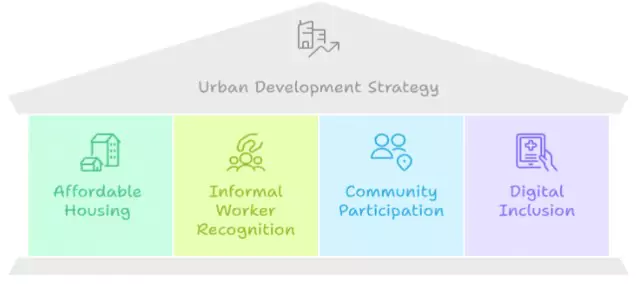Core Demand of the Question
- Discuss arguments for urbanization leading to more segregation and/or marginalization of the poor in Indian metropolises
- Discuss arguments against urbanization leading to more segregation and/or marginalization of the poor in Indian metropolises
|
Answer
Introduction
The allure of Indian metropolises draws millions with the promise of employment and prosperity. Yet, the reality of urban life often paints a different picture for the most vulnerable. This exploration assesses urbanization’s role in segregating and marginalizing the poor, and the resulting human cost and challenges to equitable city-building.
Body
Arguments for Urbanization Leading to Segregation/Marginalization of the Poor
- Rise of informal settlements: Rapid urbanization often outpaces the supply of affordable housing, pushing migrants and the urban poor into unplanned slums.
Eg: Dharavi in Mumbai, one of Asia’s largest slums.
- Gentrification and displacement: Redevelopment and beautification projects tend to evict slum dwellers without adequate rehabilitation.
Eg: The Yamuna Pushta evictions displaced thousands for riverfront beautification ahead of global events.
- Unequal access to services: Slum residents often lack clean drinking water, quality healthcare, and public sanitation, worsening their living conditions.
- Social segregation by design: Urban planning often fosters spatial division through exclusive gated communities and limited public spaces.
- Neglect in urban planning: Master Plans frequently focus on commercial growth and elite housing, sidelining low-income housing needs.
Eg: The Delhi Master Plan 2041 initially lacked strong provisions for EWS housing near employment hubs.
Arguments Against Urbanization Leading to Segregation/Marginalization
- Economic opportunities: Cities offer employment in formal and informal sectors, helping migrants improve their livelihoods.
Eg: Construction work provides daily wages to thousands of migrants.
- Improved access to services: Urban areas provide better connectivity, healthcare, and schooling compared to rural belts.
- Welfare schemes: Government programs aim to reduce urban inequality.
Eg: PM Awas Yojana (Urban) targets affordable housing for EWS and LIG families.
- Slum rehabilitation models: Progressive schemes offer formal housing and amenities.
Eg: Slum Rehabilitation Authority schemes rehouse slum dwellers with improved services.
- Urban governance innovations: Participatory tools like ward sabhas ensure the poor have a voice.
Way Ahead

- Affordable housing push: Accelerate public rental housing and PMAY delivery in urban slums.
Eg: Ahmedabad’s housing board has initiated low-cost rental models for migrant workers.
- Recognize informal workers: Provide legal identity and protection to vendors and domestic workers.
Eg: The Street Vendors Act, 2014 ensures vending zones and licenses.
- Promote community participation: Involve slum associations in municipal planning.
Eg: Mumbai’s ALMs (Advanced Locality Management) allow local input into civic issues.
- Ensure digital inclusion: Strengthen access to online welfare schemes and services.
Eg: Digital Seva Kendras in urban poor areas can bridge the digital divide.
Conclusion
Urbanization in India must shift from being economy-centric to equity-centric, aligning with SDG 11 (Sustainable Cities) and SDG 10 (Reduced Inequalities), to ensure that growth empowers the urban poor who are essential to the city’s daily functioning.
To get PDF version, Please click on "Print PDF" button.


Latest Comments